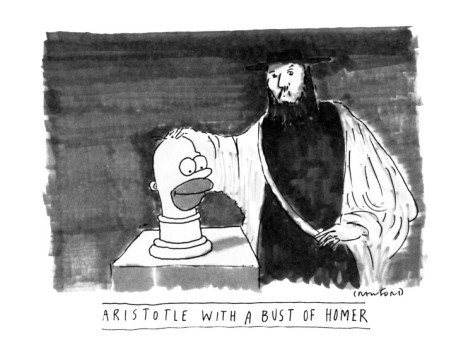Rene Girard, Violence and the Sacred
According to Girard, order and peace within a community depend on the proper maintenance of cultural distinctions. Human desire, however, acts as a mechanism giving rise to rivalry, violence, and disorder, which erase the distinctions upon which order and peace are founded. Girard views Greek tragedy as the genre that best exemplifies the tendency of violence to erase social distinctions:
The tragedians portray men and women caught up in a form of violence too impersonal in its workings, too brutal in its results, to allow any sort of value judgment, any sort of distinction, subtle or simplistic, to be drawn between "good" and "wicked" characters (47).
Girard makes interesting use of Shakespeare to support the counterintuitive idea that it is the erasing of distinctions in society, not their presence, that gives rise to violence:
…Oh, when degree is shaked
Which is the ladder to all high designs,
The enterprise is sick! How could communities,
Degrees in schools, and brotherhoods in cities,
Peaceful commerce from dividable shores,
The primogenitive and due of birth,
Prerogatives of age, crowns, scepters, laurels,
But, by degree, stand in authentic place?
Take but degree away, untune that string,
And, hark, what discord follows! Each thing meets
In mere oppugnancy, the bounded waters
Should lift their bosoms higher than the shores,
And make a sop of all this solid globe:
Strength should be lord of imbecility,
And the ruder son should strike the father dead:
Force should be right; or rather, right and wrong
Between whose endless justice resides,
Should lose their names, and so should justice too.
Troilus and Cressida
Girard argues that social instability may reach such a point of crisis that all the "internal tensions, feuds, and rivalries pent up within the community" can only be resolved through a further collective act of violence directed at a scapegoat victim (7). It is important to note in regard to Girard's theory—at least as put forth in Violence and the Sacred —that the scapegoat should not be thought of merely as an innocent victim of an act of collective violence, for in that case the scapegoat would not be able to attract to himself or herself the violent impulses of society. Nor (73) should the scapegoat be too much like the community whose interest he or she is serving, for if so violence against the scapegoat would call forth reprisals from relatives and others which would only exacerbate the social crisis ( 13). The king and the fool , Girard maintains, are likely candidates for scapegoating, since, he argues, the king is isolated from his fellows—he escapes from society 'via the roof,' as it were. Girard considers the very rich to comprise one class of marginal insiders. The fool, on the other hand, escapes from society through the cellar.
For Girard, Sophocles' Oedipus Tyrannus comprises the summit of creative achievement in laying bare the method of ameliorating social crisis through scapegoating. In this regard, Girard describes the city of Thebes as facing a social and religious crisis of startling dimensions. Laius, Oedipus, Creon, and Tiresias are all guilty alike of practicing "symmetrical violence" against one another (35). All four, therefore, share responsibility for undermining the institutions of monarchy and religion ( 71).10 First of all, long before the beginning of the play, Laius, taking his cue from the oracle, violently rejected Oedipus, fearing that his son would usurp the throne of Thebes. Oedipus in turn committed an act of reciprocal violence by killing his father, doing away with the Sphinx, and replacing both as "king and 'scourge' of the city" (48). Within the play itself, Oedipus, Creon, and Tiresias, taking their cues from the oracle, all seek likewise to destroy one another (48), so that a certain "uniform condition of violence" characterizes relations among them, any observable difference being either "illusory or quickly defaced" (70). According to Girard, the only significant difference among the three is that no one is present at the end of the play to protest against fixing guilt for regicide on Oedipus alone (78). Girard goes beyond ascribing equal shares of guilt to Laius, Oedipus, Creon, and Tiresias. As his theory demands, he assigns responsibility for the play's social and religious crisis equally to the citizens of Thebes in general. Within the city, he says, a "thousand individual conflicts" rage among "a thousand enemy brothers" (79). Everyone in Thebes is equally responsible for the plague ravaging their city (2004, 54), and the plague itself, according to Girard, is a metaphor (2004, 81), "merely a euphemism for the state of things that condemns men to the deadly strife of enemy brothers" ( 72). In such a situation, Girard (78) says, "The old pattern of each against another gives way to the unified antagonism of all against one." While no citizen of Thebes is more guilty or innocent than any of his fellows, Oedipus is selected as a single scapegoat victim, whose eventual expulsion will solve the religious and social crisis for which the plague is a metaphor.
Questions for discussion:
1.Is Girard correct that all hierarchies and divisions within Thebes have broken down in Sophocles’ Oedipus?
2.Is Sophocles’ Oedipus a Girardian scapegoat for the city of Thebes?
3.Does Girard’s theory of scapegoating have relevance to Seneca’s play?
4.Had something occurred in Seneca’s Thebes that has abolished distinctions and degrees and led to the decay of society in the manner Girard envisions?





